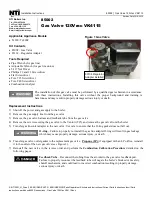
1-21
INSTALLATION
SL 80-399 MODULATING GAS BOILER
SL 26-260 G3, SL 40-399 G3 MODULATING GAS BOILERS
1.6 WATER PIPING
1.6.1 General Piping Issues
Primary/secondary piping, or the use of a hydraulic separator is recommended for
maximum flexibility in multi-load applications, but piping loads in parallel is also
encouraged in systems that only have two loads, or when loads are operating
simultaneously. The extremely low pressure drop through the SL Series heat exchanger
allows many options not available in other designs. In short – IBC has built a boiler that
will allow you to pipe the system the way you prefer, rather than try and dictate your piping
practices from boiler to radiator.
SL 26-260 G3
These boilers are designed for use within a closed loop, forced circulation, low pressure
system. A 30 psi pressure relief valve (3/4” NPT) is supplied for field installation at one
of the locations shown in the following illustrations. Relief valve discharge piping must
terminate between 6” (15cm) and 12” (30cm) above the floor or per local Code.
SL 40-399 G3
These boilers are designed for use within a closed loop, forced circulation, low pressure
system. A 30 psi pressure relief valve (3/4" NPT) is supplied for field installation in the
relief valve fitting on top of the boiler. An optional 75 Psig relief valve can be used where
required on closed loop systems within multi-level buildings. Relief valve discharge piping
must terminate between 6" (15cm) and 12” (30cm) above the floor or per local Code.
Figure 26: Boiler trim options - Single boiler
System piping is connected to the boiler using the 1 1/2" NPT-M threaded fittings.
Unions and gate or ball valves at the boilers supply and return water connections are
recommended to simplify servicing. Un-insulated hot water pipes must be installed with a
minimum 1/4" clearance from combustible materials.
WARNING
During operation, the relief valve
may discharge large amounts
of steam and/or hot water.
Therefore, to reduce the potential
for bodily injury and property
damage, a discharge line MUST
be installed that it:
1.
is connected from the
valve outlet with no intervening
valve and directed downward
to a safe point of discharge.
2.
allows complete
drainage
of both the valve and
the discharge line.
3.
is independently
supported and securely
anchored so as to avoid
applied stress on the valve.
4.
is as short and straight
as possible
5.
terminates freely
to
atmosphere where any
discharge will be clearly visible
and is at no risk of freezing.
6.
terminates with a plain
end which is not threaded.
7.
is constructed of a
material suitable for exposure
to temperatures of 375°F or
greater.
8.
is, over its entire length,
of a pipe size equal to or
greater than that of the valve
outlet.
DO NOT CAP, PLUG OR OTHERWISE
OBSTRUCT THE DISCHARGE PIPE
OUTLET!
CAUTION
Installers should inquire of
local water purveyors as to the
suitability of their supply for use
in hydronic heating systems.
If water quality is questionable,
a local water treatment expert
must be consulted for testing,
assessment and, if required,
treatment.
Alternatively, water or hydronic
fluid of known quality can be
brought to the site.
















































